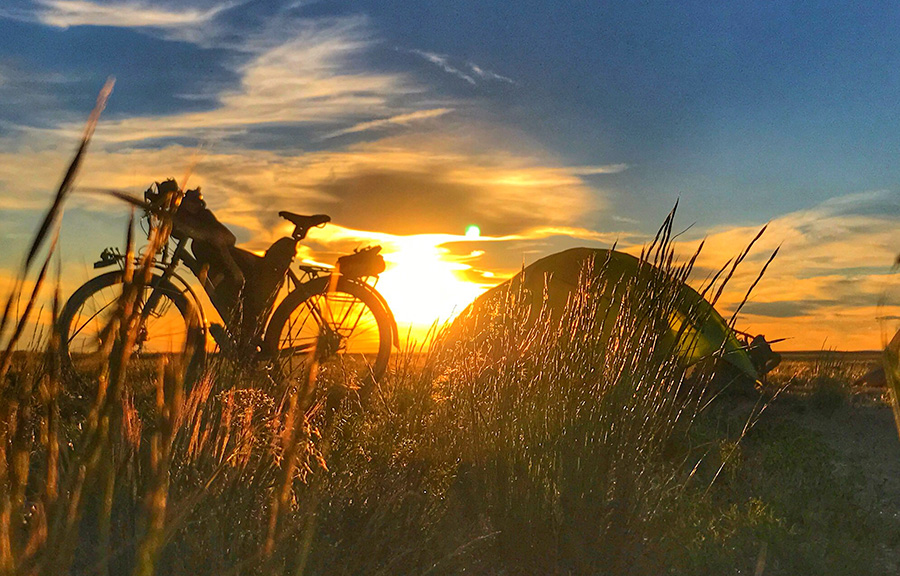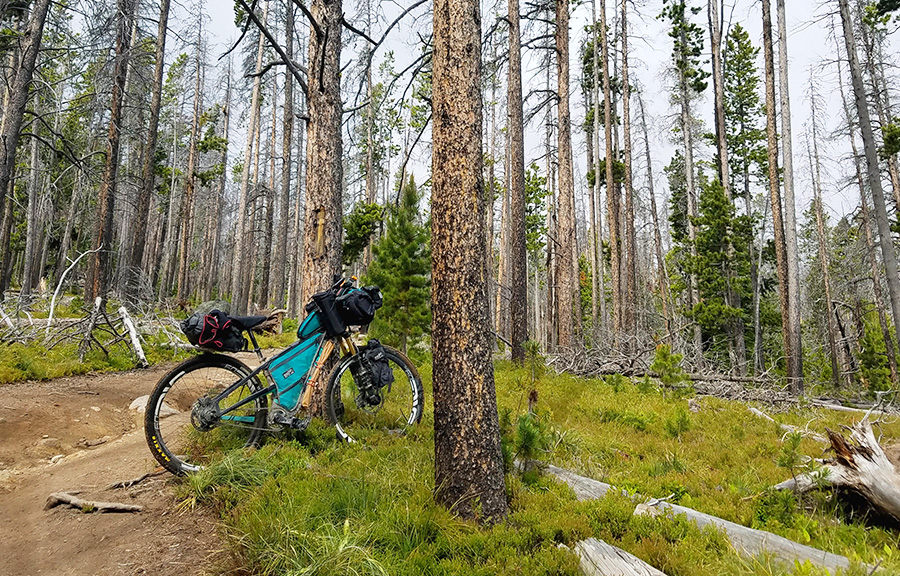Bikepacking: Less Gear, More Fun
There’s nothing magical or particularly difficult about lightening your touring load. It simply requires planning, cutthroat packing, and a possible financial investment in new gear. Touring in the backcountry is easily possible, and comfortable, with a base gear weight of ten pounds (base gear weight includes all gear carried except food and water).
To achieve this keep in mind the three key principles of ultralight travel: 1) minimize your gear, 2) make it as light as possible, and 3) eliminate redundancy and find multiple uses for as many items as possible.
Here’s a quick look at the gear and strategy anyone can use to lighten up and make their next tour less laborious and more fun.
To see detailed packing lists from Jeff Boatman, John Stamsted, and myself from our July trip in the Canadian Rockies, check out our packing lists. Boatman’s list alone, displaying his typical meticulous preparation, is a graduate-level course for the newbie bikepacker.
Shelter
The lightest shelters will always be tarps, which work well when rigged correctly and weigh less than a pound. But the good news for those who prefer the security of tents is that recent breakthroughs in materials and design have produced stormproof shelters that weigh no more than two pounds per person. Big Agnes leads the pack here with their various SL (superlight) tents, all of which can be pitched in "fast-fly" mode with only the fly, floor, and poles, for a stormproof shelter that can weigh as little as one pound per person, depending on the model. Tarptent and Big Sky International also offer impressively lightweight, high-quality tents.

Sleeping Bags and Pads
There are now a plethora of options for comfortable sleeping pads that weigh around one pound, and some people get by with austere pads that weigh much less. I’m a big fan of 72-inch Therm-a-Rest NeoAirs, which weigh 14 ounces, are supremely comfortable, and pack down to the size of a Nalgene bottle.
The latest 30-degree, down sleeping bags and quilts weigh less than 20 ounces, making them the best choice for bicycle travel. You can get by with an even lighter bag by wearing most of your clothes when you sleep. For the lightweight traveler, clothes not worn in your sleeping bag on the coldest night of your trip are clothes you didn’t need to carry. Western Mountaineering and MontBell offer the premier boutique and mass-produced ultralight down bags available today.
Cooking and Water
Canister stoves, MSR makes some nice ones, are the lightest mechanized stoves available. Lighter still are the super simple alcohol stoves which do nothing but contain and burn denatured alcohol. You can’t adjust the flame, and they don’t boil water as fast as canister stoves, but the weight and simplicity are hard to beat. My personal favorite is the brilliantly designed Caldera Cone system from Trail Designs which offers complete cook systems — including pot, stove, fuel bottle, pot holder, etc. — starting at six ounces. The folks at Anti-Gravity Gear take the Caldera Cone system a step further by offering it in a package with a stuff sack and insulated cozies.
When it comes to water, leave the filter at home and use chlorine dioxide pills. The same chemical used to treat municipal water sources, chlorine dioxide kills giardia, the main concern in the backcountry, in 15 minutes. If water has sediment, filter it through a bandana before drinking.
If you would rather use a filter, check out lightweight ones that can attach directly to your water bladder or bottle.
Tools
This is an area where many bicycle travelers can save a lot of weight. If you’re road touring, assistance is always close at hand, so you really don’t need much beyond some allen wrenches and tools for fixing a flat or repairing a broken chain.
In the backcountry, I typically carry a small multi-tool, small Leatherman, a chain tool, two tire levers, a glueless patch kit, a pump, a FiberFix replacement spoke, Park tire boots, a derailleur hanger, two spare cleat bolts, and one spare tube per rider.

Carrying Systems
If you travel light, there’s no need to use racks, panniers, or trailers, which in itself can save you many pounds. While Carousel Design Works was the first to develop a high-performance, rackless bag system, Alaska-based Revelate Designs is another company with similar, and similarly high-quality, offerings. There are some differences between their products, but both work well and can be customized to fit traditional touring or road bikes.
Many bikepackers use a backpack to carry water, stove, tent poles, and other sundries. The lightweight Osprey Talon series is the most popular and come highly recommended for their light weight, capaciousness, and ability to carry weight comfortably.
Clothing
Ironically, self-supported riders often find it easier to go ultralight in the backcountry, where completely severing the cord makes it easier to disentangle from modern society’s overpowering World Wide Web of Stuff. Those staying on the paved and civilized roads are often tempted to lug computers and other electronics along (which I won’t touch on here) as well as an abundance of heavy clothes.
If you’re frequently staying or eating in towns, most people want something to wear other than Lycra and rain gear. To solve this, keep the multiple-function philosophy in mind. Carrying separate town-clothes is heavy; instead, find clothes that work for riding, in camp, and in town. For racy types, this might mean leaving the neon jerseys at home (which might not be such a bad thing anyway).
If you’re frequently staying or eating in towns, most people want something to wear other than Lycra and rain gear.
Outdoor Research makes an excellent line of handsome, lightweight clothes that can withstand the rigors of touring but still look "normal" in town. I’ve had good luck with BackpackingLight’s Thoroughfare Shirt and Pant. Ibex also makes high-quality wool tops, both short and long-sleeve, that work well in town and can be worn for a remarkable number of riding days while minimizing the stink factor that lycra is susceptible to.
In the backcountry, where you’re primarily concerned with performance and safety, things are simpler. Waterproof outerwear, long underwear top and bottom, riding shorts, riding shirt, insulating top, warm hat and gloves, two pairs of socks, one pair of riding shoes you can walk comfortably in, and you’re set.
For riding shoes that are comfortable off the bike, check out Pearl Izumi and Northwave; both make high-quality, SPD-compatible cycling shoes that are comfortable for walking.
